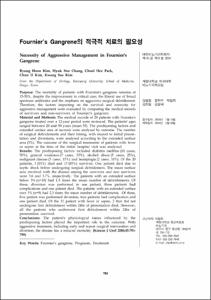Fournier's Gangrene의 적극적 치료의 필요성
- Alternative Author(s)
- Kim, Byung Hoon; Chang, Hyuk Soo; Park, Choal Hee; Kim, Chun Il; Kim, Kwang Sae
- Journal Title
- 대한비뇨기과학회지
- ISSN
- 2005-6737
- Issued Date
- 2004
- Abstract
- Purpose: The mortality of patients with Fournier's gangrene remains at 15-50%, despite the improvement in critical care, the liberal use of broad spectrum antibiotics and the emphasis on aggressive surgical debridement. Therefore, the factors impacting on the survival and necessity for aggressive management were evaluated by comparing the medical records of survivors and non-survivors of Fournier's gangrene.
Material and Methods: The medical records of 20 patients with Fournier's gangrene treated over a 12-year period were reviewed. The patients' ages ranged between 20 and 90 years (mean 55). The predisposing factors and extended surface area of necrosis were analysed by outcome. The number of surgical debridements and their timing, with respect to initial presentation and diversions, were analysed according to the extended surface area (3%). The outcome of the surgical treatments of patients with fever or sepsis at the time of the initial hospital visit was analyzed.
Results: The predisposing factors included diabetes mellitus (10 cases, 50%), general weakness (7 cases, 35%), alcohol abuse (5 cases, 25%), malignant disease (3 cases, 15%) and hemiplegia (2 cases, 10%). Of the 20 patients, 3 (15%) died and 17 (85%) survived. One patient died due to septic shock before undergoing surgical debridement. The mean surface area involved with the disease among the survivors and non survivors were 3.6 and 3.7%, respectively. The patients with an extended surface below 3% (n=10) had 1.5 times the mean number of debridements. Of these, diversion was performed in one patient, three patients had complications and one patient died. The patients with an extended surface over 3% (n=9) had 2.3 times the mean number of debridements. Of these, five patient was performed diversion, tree patients had complication and one patient died. Of the 11 patient with fever or sepsis, 2 that did not undergone first debridement within 24hr of presentation died. However, all the patients who underwent first debridement within 24hr of presentation survived.
Conclusions: The patient's physiological status influenced by the predisposing factors played the important role in the outcome. With aggressive treatment, including early and repeat surgical intervention and diversion, the disease has a reduced mortality. (Korean J Urol 2004;45:793-799)
- Alternative Title
- Necessity of Aggressive Management in Fournier's Gangrene
- Department
- Dept. of Urology (비뇨의학)
- Publisher
- School of Medicine
- Citation
- 김병훈 et al. (2004). Fournier’s Gangrene의 적극적 치료의 필요성. 대한비뇨기과학회지, 45(8), 793–799.
- Type
- Article
- ISSN
- 2005-6737
- Appears in Collections:
- 1. School of Medicine (의과대학) > Dept. of Urology (비뇨의학)
- 파일 목록
-
-
Download
 oak-bbb-1273.pdf
기타 데이터 / 272.8 kB / Adobe PDF
oak-bbb-1273.pdf
기타 데이터 / 272.8 kB / Adobe PDF
-
Items in Repository are protected by copyright, with all rights reserved, unless otherwise indicated.